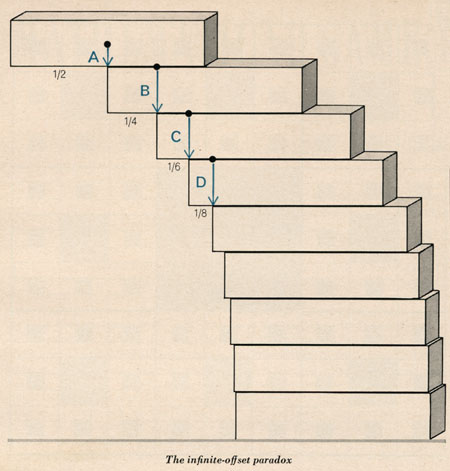The drawing below, brazenly swiped from a 1964 Martin Gardner column, illustrates the solution to a well-known puzzle. If you stack n bricks on a table, how far can you make them extend over the edge without toppling?

The answer given, for bricks of unit length, is one-half the nth harmonic number, the sum of the series 1/2 + 1/4 + 1/6 + 1/8 + … + 1/2n. Since this series diverges, the overhang can be as large as you please, given enough bricks (and a strong enough table).
In describing this result, Gardner uses the word “unbelievable,” and when I first read about it, that was my reaction too. It is one of those facts that are inescapably true, and yet still implausible. Now I learn that the truth is even stranger—that far larger overhangs can be achieved.
The overhang for the harmonic stack is approximately equal to 1/2 ln n; it turns out other stacks achieve an overhang on the order of the cube root of n. This is an enormous improvement. For a million bricks, the harmonic stack can’t get beyond 13.8 bricklengths, whereas the cube-root stack extends 100 bricklengths beyond the edge.
How is it done? I’m not telling. If you can’t figure out the trick, you’ll have to consult the links below.
The key idea in the alternative solutions has apparently been known for at least 20 years. (Actually, I’d be surprised if it wasn’t known to stonemasons centuries ago, as well as generations of children playing with wood blocks—but I don’t have a reference to support that conjecture.) Quite new, however, is the mathematical analysis showing exactly how large the overhang can be. Last year Mike Paterson of the University of Warwick and Uri Zwick of Tel Aviv University presented a paper at SODA (the Symposium on Discrete Algorithms) giving optimal solutions for n up to 30, and showing that the asymptotic rate of growth is n1/3. Now Peterson and Zwick, along with Yuval Peres (Berkeley), Mikkel Thorup (AT&T Labs) and Peter Winkler (Dartmouth) have proved that order n1/3 is the best that can achieved:
More specifically, we show that any n-block stack with an overhang of at least 6n1/3 is unbalanced, and must hence collapse. Thus we conclude that the maximum overhang with n blocks is of order n1/3.
Links: The 2006 Paterson-Zwick paper is here in the SODA proceedings (subscription required) and here in the arXiv. (It is also to appear in the American Mathematical Monthly.) The five-author proof is at the arXiv here.